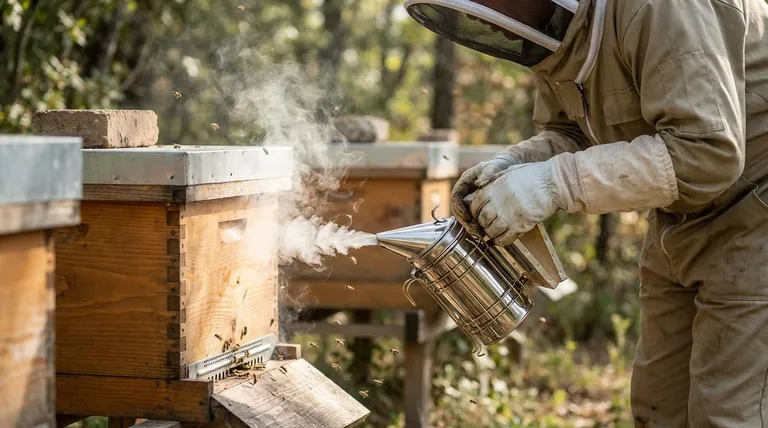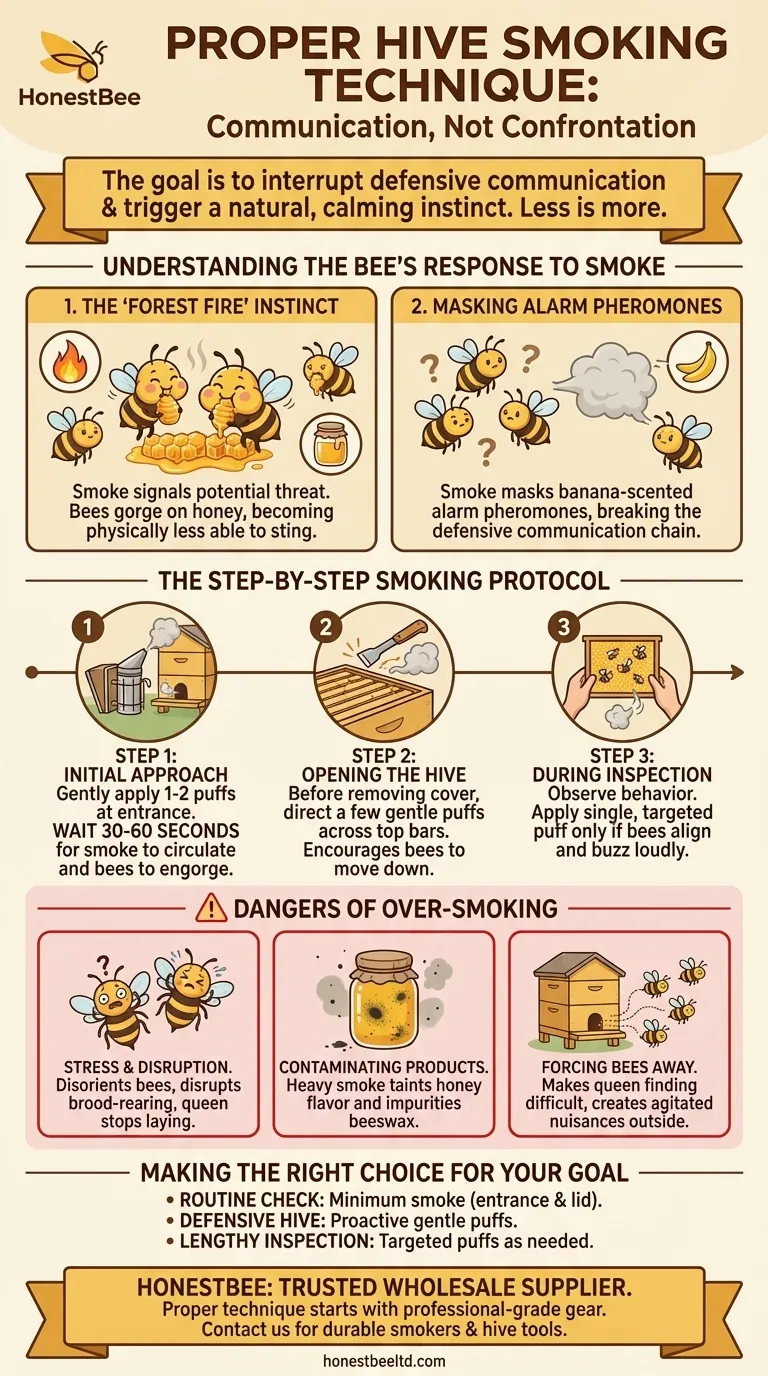Properly smoking a hive is about communication, not confrontation. The correct technique involves applying just enough smoke to calm the bees without causing undue stress. Start with one or two gentle puffs at the hive entrance, wait 30-60 seconds, and then apply another one or two puffs under the lid as you open it.
The goal of smoking a hive is not to sedate the bees, but to interrupt their defensive communication and trigger a natural, calming instinct. Less is almost always more.

Understanding the Bee's Response to Smoke
To use a smoker effectively, you must first understand why it works. The smoke triggers two key instinctual responses in honey bees.
The 'Forest Fire' Instinct
Smoke signals a potential threat to the colony: a forest fire. This initiates a survival protocol where bees prepare to abandon the hive if necessary.
Their first action is to consume as much honey as possible. A bee with a full stomach of honey is physically less able to flex its abdomen to sting, making it more docile.
Masking Alarm Pheromones
When a bee feels threatened or stings, it releases an alarm pheromone that smells like bananas. This chemical signal alerts other bees in the vicinity to the danger, inciting a coordinated defensive attack.
Smoke effectively masks these pheromones, breaking the chain of communication and preventing a mass defensive response from escalating.
The Step-by-Step Smoking Protocol
A calm and methodical approach is crucial for a successful hive inspection. Rushing the process or using too much force will only agitate the colony.
Step 1: The Initial Approach
Gently apply one or two puffs of cool, white smoke into the hive entrance. This is your initial "knock on the door" that alerts the guard bees to your presence and begins the calming process.
After puffing the entrance, wait for at least 30-60 seconds. This pause gives the smoke time to circulate and the bees time to begin engorging on honey.
Step 2: Opening the Hive
After waiting, use your hive tool to crack the outer and inner covers. Before removing the cover completely, direct a few gentle puffs of smoke across the top bars of the frames.
This encourages the bees on the top of the frames to move downward, clearing your workspace and preventing them from flying up at you when the hive is fully opened.
Step 3: During the Inspection
Set your smoker aside but keep it within easy reach. As you work through the hive, observe the bees' behavior. If they begin to line up on top of a frame and face you, or if you hear a noticeable rise in the buzzing pitch, they are becoming agitated.
Apply a single, gentle puff of smoke directly over that area to calm them and push them back down between the frames.
Understanding the Trade-offs: The Dangers of Over-Smoking
Using too much smoke is a common mistake that is counterproductive and harmful to the colony.
Stress and Disruption
Excessive smoke is a significant stressor. It can disorient the bees, disrupt brood-rearing, and cause the queen to stop laying. The effects of a poorly managed inspection can set the colony's progress back for days.
Contaminating Hive Products
Heavy, sooty smoke can be absorbed by the honey and wax within the hive. This can taint the flavor of your honey and introduce impurities into the beeswax.
Forcing Bees Away
While a little smoke encourages bees to move down, a blast of smoke will cause them to flee. This can make finding the queen nearly impossible and may drive bees out of the front of the hive, where they can become agitated and a nuisance.
Making the Right Choice for Your Goal
Calibrate your use of smoke based on the temperament of the hive and the goal of your inspection.
- If your primary focus is a quick, routine check: Use the absolute minimum amount of smoke; you may only need it at the entrance and once under the lid.
- If you are working a known defensive or 'hot' hive: Be prepared with a well-lit smoker and apply gentle puffs proactively to keep the bees from escalating their defense.
- If you are performing a lengthy inspection (e.g., looking for the queen): Apply small, targeted puffs of smoke as needed to maintain a calm environment throughout the process.
By using smoke as a precise tool for communication, you transform hive inspections into a calm and productive experience for both you and your bees.
Summary Table:
| Step | Action | Purpose |
|---|---|---|
| 1. Initial Approach | 1-2 puffs at entrance, wait 30-60 sec | Triggers 'forest fire' instinct; bees engorge on honey, becoming docile. |
| 2. Opening Hive | A few puffs under the lid before removing | Encourages bees to move down, clearing workspace and preventing agitation. |
| 3. During Inspection | Small, targeted puffs only if bees show agitation | Calms defensive behavior without over-stressing the colony. |
| Key Principle | Use minimal, cool, white smoke | Avoids contaminating honey/wax and prevents undue stress on the bees. |
Ensure every hive inspection is a success with the right equipment from HONESTBEE.
As a trusted wholesale supplier to commercial apiaries and beekeeping equipment distributors, we provide the durable, reliable smokers and hive tools you need to apply these techniques effectively. Proper technique starts with professional-grade gear.
Contact our team today to discuss your wholesale supply needs and learn how HONESTBEE supports the productivity and safety of large-scale beekeeping operations.
Visual Guide

Related Products
- Stainless Steel Honey Bee Smoker Hive and Honeycomb Smoker for Beekeeping
- European Stainless Steel Bee Smoker for Honey Bee Hive
- Stainless Steel Electric Beehive Smoker for Beekeeping and Bee Keeper Use
- Premium Traditional Copper Bee Smoker with Bellows
- Economy Galvanized Beekeeping Honey Bee Smoker for Wholesale
People Also Ask
- How did early beekeepers use bee smokers? Master Ancient Bee Calming Techniques
- What is the primary purpose of using smoke in beekeeping? Calm Bees for Safer Hive Management
- What is the proper technique for lighting a bee smoker? Master the Layered Fire Method for Calm Hives
- What is a bee smoker and how does it work? Master the Tool for Calm, Safe Hive Inspections
- What is a Smoker and how is it used in beekeeping? The Essential Tool for Calm, Safe Hive Inspections



















